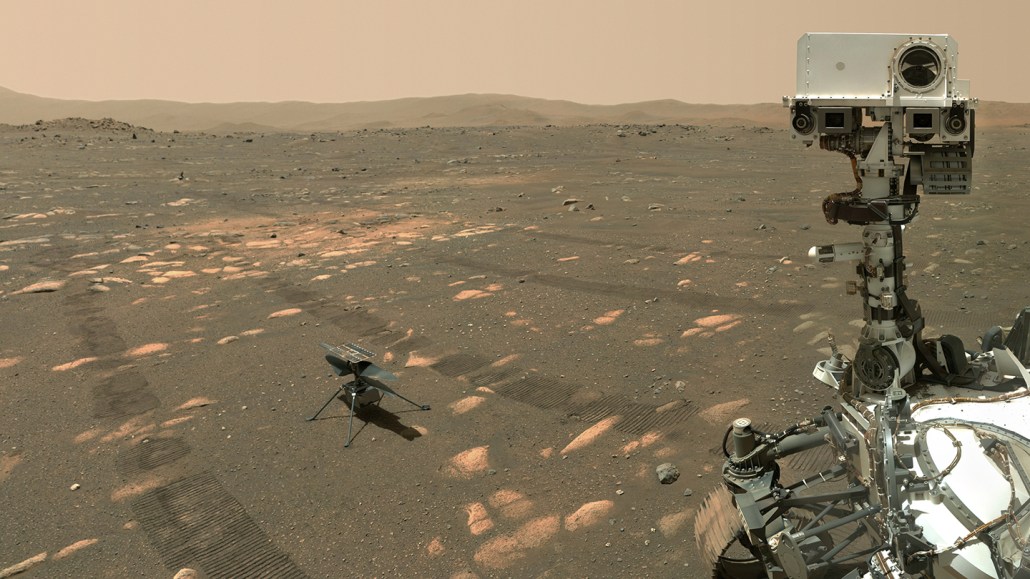Mars has two speeds of sound
Its speed depends on whether the sound is high-pitched or low-pitched

The SuperCam instrument (upper right) on NASA’s Perseverance rover includes a microphone, which picked up sounds from the instrument’s laser and from the whirling blades on the Ingenuity helicopter (left).
JPL-Caltech/NASA, MSSS
On Mars, the speed of sound depends on its pitch.
All sound travels slower through Mars’ air compared with Earth’s. But the higher-pitched clacks of a laser zapping rocks travels slightly faster in the thin Martian atmosphere than the lower-pitched hum of the Ingenuity helicopter, researchers report April 1 in Nature.
These sound speed measurements from NASA’s Perseverance rover are part of a broader effort to monitor minute-by-minute changes in atmospheric pressure and temperature, like during wind gusts, on the Red Planet.
“The wind is the sound of science for us,” says astrophysicist Baptiste Chide of Los Alamos National Laboratory in New Mexico.
To listen to the wind, Perseverance carries two microphones. One was meant to record audio during the mission’s complex entry, descent and landing, and while it didn’t work as hoped, it is now turned on occasionally to listen to the rover’s vitals (SN: 2/22/21; SN: 2/17/21). The other microphone is part of the rover’s SuperCam instrument, a mast-mounted mishmash of cameras and other sensors used to understand the properties of materials on the planet’s surface.
But these microphones also pick up other sounds, such as those made by the rover itself as its wheels crunch the surface, and by Perseverance’s flying companion, the robotic helicopter Ingenuity. The SuperCam instrument, for example, has a laser, which Perseverance fires at interesting rocks for further analysis (SN: 7/28/20). The microphone on SuperCam captures sounds from those laser shots, which helps researchers learn about the hardness of the target material, says planetary scientist Naomi Murdoch of the Institut Supérieur de l’Aéronautique et de l’Espace in Toulouse, France.
Murdoch, Chide and their colleagues listened to the laser’s clack-clack when zapping rocks. (“It doesn’t do, really, ‘pew pew,’” Murdoch says). When the laser hits a target, that blast creates a sound wave. Because scientists know when the laser fires and how far away a target is, they can measure the speed at which that sound wave travels through the air toward the SuperCam microphone.
Laser zaps
This recording from a microphone onboard NASA’s Perseverance rover on Mars captures the clacking sound of the robot’s laser zapping rocks.
The speed of this sound is about 250 meters per second, the team reports. That’s slower than on Earth, where sound travels through the air at about 340 m/s.
The slower speed isn’t surprising. What we hear as sound is actually pressure waves traveling through a medium like air, and the speed of those waves depends on the medium’s density and composition (SN: 10/9/20). Our planet’s atmosphere is 160 times as dense as the Martian atmosphere, and Earth’s air is mostly nitrogen and oxygen, whereas the Martian air is predominately carbon dioxide. So sound on Mars travels slower in that different air.
The team also used the SuperCam microphone to listen to the lower-pitch whirl of Ingenuity’s helicopter blades (SN: 12/10/21). From this lower-pitched sound, the researchers learned that there is a second speed of sound at the Martian surface at frequencies below 240 hertz, or slightly deeper than middle C on a piano: 240 m/s.
Helicopter hum
This recording from the same microphone captures wind gusts and the distant hum of the Ingenuity helicopter’s blades, as the helicopter touches down about 80 meters from the rover.
In contrast, at Earth’s surface, sound moves through the air at only one speed, no matter the pitch. The two speeds on Mars, the researchers say, are because of its carbon dioxide–rich atmosphere. Carbon dioxide molecules behave differently with one another when sound waves with frequencies above 240 hertz move through the air compared with those below 240 hertz, affecting the waves’ speed.
“We’ve proved that we can do science with a microphone on Mars,” Chide says. “We can do good science.”
The SuperCam microphone captures thousands of sound snippets per second. Those sounds are affected by air pressures, so the researchers can use that acoustic data to track detailed changes in air pressures over short timescales, and, in doing so, learn more about the Martian climate. While other Mars rovers have had wind, temperature and pressure sensors, those could sense changes only over longer periods.
“Listening to sounds on another planet is another way that helps all of us place ourselves as if we were there,” says Melissa Trainer, a planetary scientist at NASA’s Goddard Space Flight Center in Greenbelt, Md., who was not part of this work.
The team is focusing on next collecting acoustic data at different times of day and different seasons on Mars.
“The pressure changes a lot on Mars throughout the year with the seasons,” Trainer says. “I’m really excited to see how the data might change as it gets collected through proceeding seasons.”







